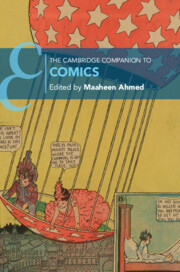Book contents
- The Cambridge Companion to Comics
- The Cambridge Companion to Comics
- Copyright page
- Contents
- Figures
- Contributors
- Acknowledgments
- Chronology
- Introduction
- Part I Forms
- Chapter 1 Comics Drawing
- Chapter 2 Comics, Media Culture, and Seriality
- Chapter 3 Comics and Graphic Novels
- Chapter 4 Manga
- Chapter 5 Digital Comics
- Part II Readings
- Part III Uses
- Further Reading
- Index
- Cambridge Companions To …
- References
Chapter 1 - Comics Drawing
A (Poly)Graphic History
from Part I - Forms
Published online by Cambridge University Press: 17 August 2023
- The Cambridge Companion to Comics
- The Cambridge Companion to Comics
- Copyright page
- Contents
- Figures
- Contributors
- Acknowledgments
- Chronology
- Introduction
- Part I Forms
- Chapter 1 Comics Drawing
- Chapter 2 Comics, Media Culture, and Seriality
- Chapter 3 Comics and Graphic Novels
- Chapter 4 Manga
- Chapter 5 Digital Comics
- Part II Readings
- Part III Uses
- Further Reading
- Index
- Cambridge Companions To …
- References
Summary
This chapter contextualizes narrative drawing, first identifying the types of drawing that are specific to comics. It proposes that the comics medium intervenes in the long history of drawing, by introducing polygraphy as a recurrent feature of comics. Referring to Bakhtin’s concept of polyphony (or multiple voices) in the novel, polygraphy accounts for the techniques of accumulating diverse graphic indices of the labor and ideas of drafters and comics producers and distributors. The chapter shows how polygraphy produces comics, considering the work of William Hogarth, Katsushika Hokusai, Rodolphe Töpffer, Marie Duval, George Herriman, Winsor McCay, and Osamu Tezuka. Through this cast of creators, the chapter also foregrounds important moments in comics history such as the boom in periodical print in the nineteenth century, the influence of acting and performance practices, and, later, movie. This chapter equips readers with the necessary tools to understand the fundamental means of visualizing stories in comics – drawing – and offers a comics history contextualized through relevant developments in popular visual and print culture.
- Type
- Chapter
- Information
- The Cambridge Companion to Comics , pp. 25 - 45Publisher: Cambridge University PressPrint publication year: 2023



